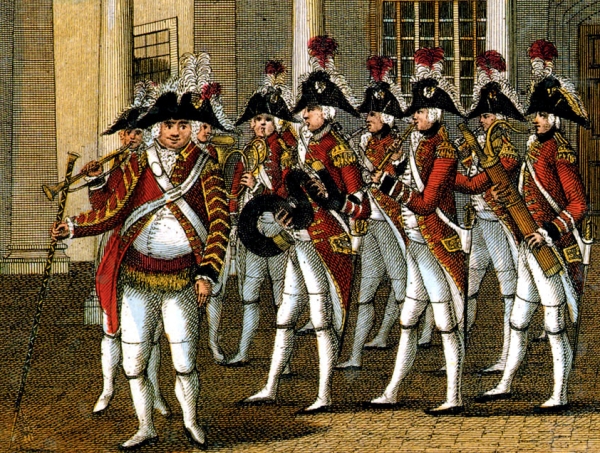Back in March, I promised a series of posts on bands of music covering the years leading up to the American War for Independence and the war itself. Well, when I was first looking at what I had in April, I definitely had enough for a couple of postings. A lot has happened since then and I now have enough information for a honours thesis. For the purposes of this little series, we’re gonna scale it back and start at the basics. Part one of this series is going to answer one of the most common questions I get asked: What is a band of music (BoM) and how are these musicians* different from fifers and drummers?
Martial music in the 18th century usually conjures up an images of drummers and fifers but they’re only half the equation. The British, French, Hessians, and Continental Armies all had bands of music with them. Unlike the fifes and drums, these bands are playing harmoniemusik. Harmonie is German in origin, meaning an ensemble of usually 5-8 wind instruments playing music for outdoor or recreational purposes. Music composed for harmonie is called harmoniemusik.

Detail, His Majesty Reviewing the Volunteer Corps Assembled in Hyde Park, 4 June, 1799, J. Boydell, ASKB Military Collection
So right off the bat, the music the bands are playing is separate from that of the fifes and drums. Bands of music are purely for recreational or ceremonial purposes unlike drums and fifes, used for military duties as well as ceremonies.
Interestingly, bands of music are not official entities within regiments and instead are a luxury. British regulations allowed for one drummer per company, two drummers for the grenadiers (other drummer could be a fifer; a majority of regiments still recruited fifers anyways). The Continental Army’s regulations stated there was to be one drummer and one fifer per company. If a regiment were to have a BoM, it would have to come (theoretically) out of the officers’ pockets, though some snuck them in on the roll as enlisted men.
So if Bands of Music aren’t playing fifes and drums, what are they playing? Well, it varies by band. John Hancock’s elite militia unit, the Corps of Cadets, had their own band. When the instruments went missing after the Siege of Boston was lifted and the army marched out, Hancock wrote General Schuyler in September of 1776 saying that he was missing “…French horns, Bassoons & other Instruments of Musick.” Hautboys (Oboes), serpents, clarinets, and percussion instruments like the bass drum, cymbals, and jingling johnny are also common to find in returns and descriptions.

Changing of the Guards in front of St. James Palace, Circa 1790. Note the turbans and Eastern instruments. Anything Turkish or Janissary is incredibly popular in the latter part of the 18th century. There are countless songs on fife called “Turks/Turkish March” or “Janissary’s March.” Having black musicians/fifers or drummers is also considered another showpiece for the regiment.

Detail from above. Note that the band and the fifes and drums are two separate entities, not massed together.
In summary, bands of music are groups of musicians belonging to a regiment (unofficially) that play pieces vastly different than fifes and drums. They are not used for martial duty but instead for pleasure and ceremony. Their instrumentation is vastly different from their drum and fife counterparts.
In the next segment, we’ll take a look at bands of music in America before the outbreak of hostilities.
*For the purposes of this series, musicians will refer to members of a band of music and not drummers and fifers.
